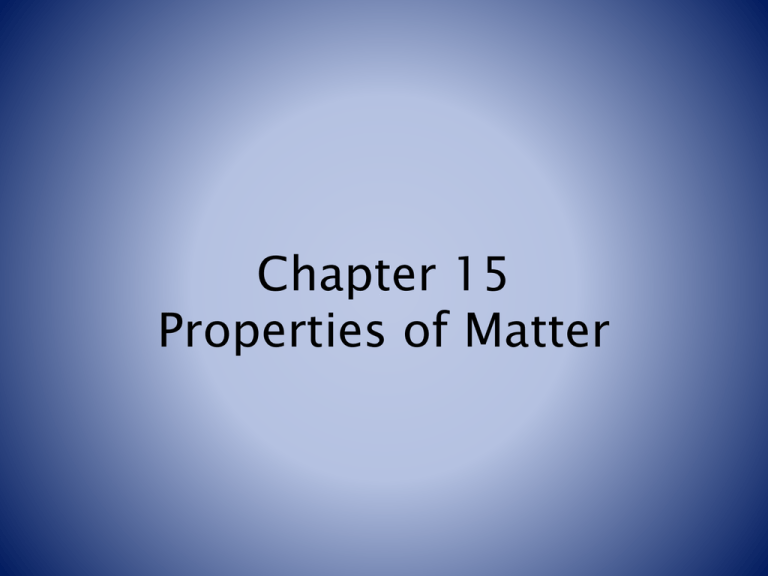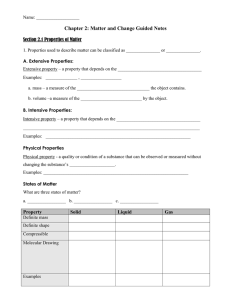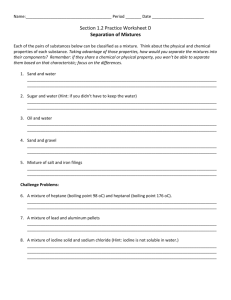matter chapter 15version3
advertisement

Chapter 15 Properties of Matter Classifying Matter • Matter is a term used to describe any material that has mass and takes up space. • Matter can be classified as either a mixture or a substance. – Substances can either be elements or compounds. • Matter has different characteristics such as: boiling and melting temperatures, hardness, density, elasticity What is A Mixture? • A mixture is made out of more than one kind of matter • An example is soda, because it can be separated into carbonated water, corn syrup, caramel color, phosphoric acid, natural flavors and caffeine • There are two types of mixtures, heterogeneous and homogenous Types of Mixtures • A Homogeneous mixture is the same throughout. All samples of this type of mixture would be the same. Examples: soda, salt water, brass (a mixture of copper and zinc) – A solution is a type of homogeneous mixture with particles that are so small they cannot be seen with a microscope. Made with water (solvent) and a solute such as salt – An alloy is a solid mixture, such as brass. You must melt the metals to mix them • A Heterogeneous mixture has different parts that are visible in the mixture. Examples: Chicken noodle soup, M&M’s, Chex mix • Sometimes heterogeneous mixtures are hard to see (a cotton polyester blend shirt for example) Colloids • A colloid is a mixture with larger particles than in a solution, but not heavy enough to settle out. (ex.- milk, fog) • Detected by the Tyndall Effect, in a colloid light beams are scattered and you can see the beam easily Suspensions • Heterogeneous mixture in which large particles settle • Muddy pond water • They do scatter light like colloids, but the particles are much larger and some actually settle out of solution Mixtures vs. Substances • Mixtures can be separated into different types of matter by physical means • Substances cannot be separated easily • Substances include: – Elements- The smallest sample of matter, contains only one type of atom (silver, oxygen) – Compounds: Two or more elements joined together chemically and cannot be separated by physical means ( water, salt, sugar) Properties of Matter • Physical Properties – characteristics of a material which can be observed without changing the identity of the material. (size, shape, color) • Chemical Properties – characteristics of a substance indicating that it can change chemically. (flammability) Properties of Solids Hardness • Resistance to scratching • Talc is the softest – baby powder • Diamond is the hardest Elasticity • Ability to stretch and return to the original form • Gives the ability to bounce and withstand an impact Brittleness • Tendency to shatter on impact - glass • Safety glass is coated with cellulose nitrate • Enhanced protective glass – two pieces of glass with Saflex in between – used in cars and as a sound barrier Malleability • Solids ability to be pounded into sheets • Aluminum foil Ductility • Ability to be pulled into thin wire • Gold and silver Tensile strength • A measure of how much tension or pulling that a material can withstand • Strength of rope, fiber, and cables • Kevlar - is constructed of para-aramid fibers which are five times stronger than the same weight of steel, while being lightweight, flexible and comfortable. It is also very heat resistant and decomposes above 400 °C without melting. More Properties of Solids • • • • • • • • Boiling point Melting point Color Conductivity Mass Odor Shape State of Matter Measuring Matter • Mass- amount of matter in an object • Measured in grams or Kg • Use a triple beam or electronic balance to determine • You can get the mass of a liquid by massing it in the container and subtracting the mass of the container Volume • Volume- Amount of space something takes up • Volume of a liquiduse a graduated cylinder • Volume of a solidlxwxh • Displacement Displacement • Use the displacement of liquid in a graduated cylinder to determine the volume of an object • Useful for small, irregularly shaped objects How to measure volume using displacement • Pour an even volume of water into a graduated cylinder • Read the volume • Drop the object in the water • Read the volume • Subtract to get the volume of the object Density • Relationship between mass and volume • Tells us how tightly the atoms or molecules in a material are packed together • Higher density – atoms are closer together • Lower density- atoms farther apart • Size and shape do not effect density M D V Density • You must have the volume and the mass to calculate density. • A material’s density is a physical property and stays the same for that particular material, but can vary due to state of matter and temperature Units: Mass in kg or g Volume in cm3 or mL Density in g/cm3, g/mL, kg/cm3, kg/mL • Most of the time will be the first two • • • • Density and Temperature • As the temperature increases, density decreases • A solid that is warm will have a slightly lower density than a solid that is cold • The same is true for gases and liquids Density of liquids • In liquids the volume increases because the molecules are moving more quickly • The volume increases so density decreases • Liquid silver is less dense than solid silver • Water is an exception– ice floats on water • Solid water is less dense than liquid– this is important in nature Density Lab • While vacationing in California, you find a large chunk of metal that appears to be gold. How can you make sure you struck it rich without letting anyone else know about the find? Lucky you, you remember that all materials have a density that is specific to themselves. • So the first thing you do is look up the density of gold. So then you measure the mass of your sample. So then you measure the volume of your sample. • Unfortunately the sample is an odd shape, but you remember from your physical science class how to measure volume by the displacement method. Do you have Gold? YES!!!!!! Now, let’s see how rich you are. Gold is currently selling at $1,664.00 / ounce 1 ounce = 28.35 grams





